Got a client who is in love with traditional English gardens? Whether they’re nestled in the countryside or the heart of a bustling city, this guide is your key to designing a landscape with English garden flair.
We’ll cover the basics of English garden design, tailored for any location, and provide a toolkit for creating timeless English garden elegance. Plus we’ll throw in a few professional tips and some help from Contemporary Style Design’s innovative design software.
Let’s start with the basics…what is an English garden?
What Is An English Garden & Its Main Design Elements?
The quintessential English Garden blends formal with informal elements to create a space where nature meets artistry. It’s an idyllic landscape that tells a story through its design, inviting a leisurely stroll or a restful pause.
At the heart of an English Garden lies the intent to coexist with nature rather than dominate it. This provides a harmonious retreat that has charmed garden enthusiasts for centuries.
Here are the core design elements that define an English Garden:
Symmetry and Structure: While English Gardens have a reputation for their flowing and natural appearance, underlying this seemingly wild beauty is a backbone of symmetry. Traditional layouts start with a central axis, which then gives way to more fluid and organic forms.
Varied Plant Life: Diversity in planting is crucial. Planting a variety of species that bloom at different times ensures year-round interest. The combination of perennials, annuals, and biennials provides a cascade of color and texture throughout the seasons.
Lush, Verdant Lawns: A well-maintained lawn serves as the canvas for the surrounding design elements. The lawn often features some flowering trees or a solitary, sculptural tree as a focal point.
Water Features: Ponds, streams, and fountains are often incorporated. These add a sense of movement and tranquility. The gentle sound of water is a soothing presence that attracts a range of wildlife.
Classic Stonework: Whether it’s a winding gravel pathway, a rustic stone bench or an ornate statue, classic stonework adds a timeless quality and structure to the softer parts of the landscape. It can define spaces, offer pathways, and create boundaries in a subtle yet effective way.
Secret Nooks and Hidden Spaces: English Gardens often play with visibility by using plantings and landscaping to create secret areas. These spaces might house a bench or a small gazebo where you can escape into the garden’s serenity.
Wildlife Encouragement: A true English Garden supports local ecology. It’s common to include birdhouses, butterfly-attracting plants, and small habitats for beneficial insects.
Climbing and Cascading Plants: Walls, trellises, and arches are adorned with climbing roses, ivy, and other vining plants. This adds vertical interest and a sense of aged beauty.
So whether you’re creating a cozy garden for a private residence or a grand outdoor space for a commercial property, these foundational elements of English Garden design give you a starting point for a landscape that’s both functional and enchanting.
Check out the next section to see how you can incorporate these elements into your designs.
How to Design an English Garden, No Matter Where You’re Located
No matter your zip code, you can design a landscape that captures an English garden’s charm. Here are some tips for making it happen.
1. Lush Plantings with Repetition
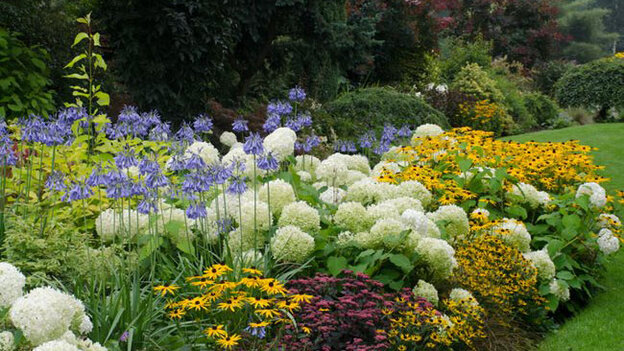
Creating a lush planting scheme is fundamental in English Garden design. The key is to achieve a balance between variety and repetition.
Repeating groups of the same plants throughout your space brings a sense of unity and rhythm. This guides the eye while reinforcing the garden’s structure.
- Opt for a mix of perennials and self-seeding annuals to fill in gaps and ensure that the garden evolves naturally over time.
- Try to incorporate varying textures and leaf sizes to add depth—think broad-leafed hostas against delicate ferns.
- And use repetition not just in plant varieties but in color themes to give each section of the garden a distinct feel while maintaining a cohesive look.
2. Hedging and Evergreens
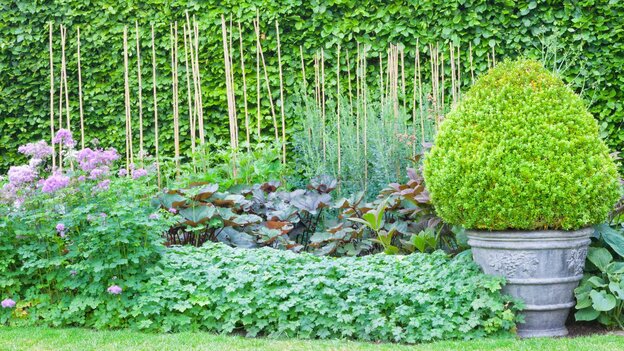
Hedging and evergreens form the backbone of an English Garden by providing structure and year-round interest.
- Boxwoods are a traditional choice for formal edges, while yew and holly can create taller privacy screens.
- Remember to consider the growth patterns and maintenance needs of these plants since some may require regular trimming to maintain sharp lines, while others are more forgiving.
- Evergreens also serve as the perfect backdrop for your flowering plants. They make their colors pop and provide contrast during the dormant winter months.
3. Garden Paths
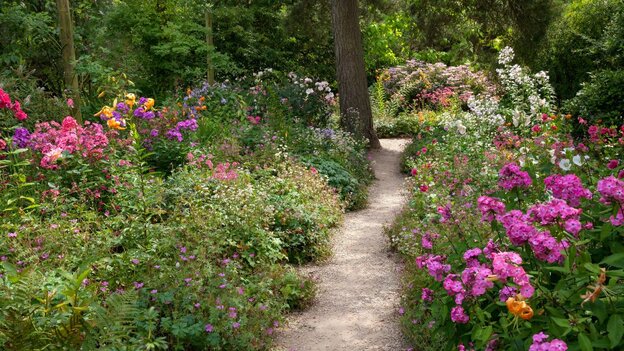
The paths in an English Garden are more than just walkways. They’re an invitation to explore.
- Consider adding meandering paths that follow the natural landscape and lead to hidden design elements, such as a bench or a secluded pond.
- Materials like gravel, brick and natural stone are commonly used and can be laid out in patterns that complement the garden’s style.
- Add borders of low-growing plants or herbs alongside paths to define the journey and offer fragrant and sensory experiences for travelers along the path.
Pro Tip! – Want to see how your garden paths will look once finished? Use a 3D design program like Contemporary Style Design to create realistic visualizations of your ideas. Not only do they help streamline the design process, but they also make great additions to your project presentations!
And best of all…with Contemporary Style Design, you don’t have to be a 3D design whiz. Its intelligent software takes care of all the heavy lifting.
Try Contemporary Style Design for FREE today!
4. Fragrant Flowering Plants
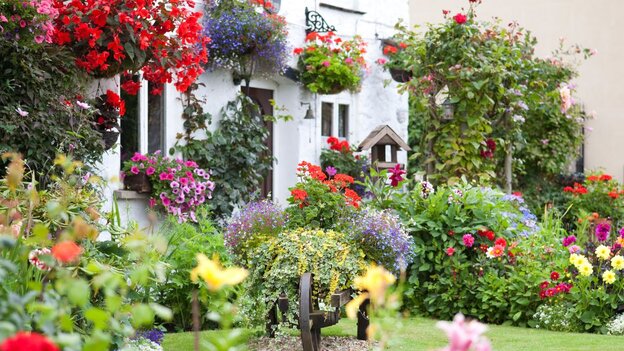
Scent is a powerful element in an English Garden. Incorporating fragrant flowering plants creates an immersive experience. Traditional choices include lavender, which provides a relaxing aroma and is also excellent for attracting pollinators. Roses are a must-have, with their classic perfume and romantic blooms.
Other fragrant flowers to consider using are:
- Peonies, with their lush, full flowers and sweet scent.
- Lilacs, known for their strong, nostalgic fragrance.
- Jasmine, which offers a potent and exotic aroma in the evening hours.
- Sweet alyssum, with its honey-like fragrance and delicate clusters of flowers.
- Lilies, with some varieties like the oriental ‘Stargazer’ or ‘Casa Blanca’, deliver a potent and majestic fragrance that can be the highlight of your scented garden.
5. Private Spaces and Seating
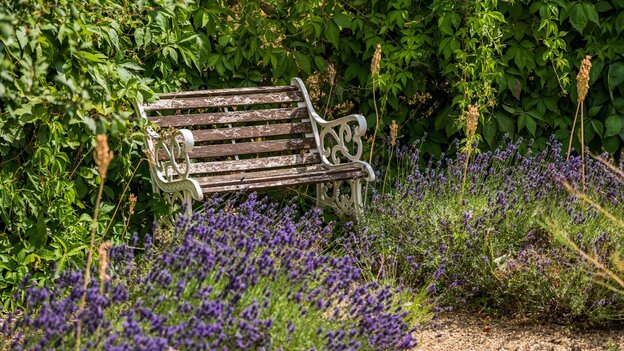
An English Garden should invite visitors to linger. That’s why creating private spaces with seating is essential. Do something as simple as a solitary bench under a leafy bower or as elaborate as a hidden gazebo covered in climbing roses.
When deciding on where to place the seating, consider both the view and the privacy. It should feel like a natural part of the garden while also providing a secluded spot for reflection or conversation.
And try to soften these seating areas with surrounding plants that offer both comfort and a sense of enclosure.
6. Roses, Roses, Roses
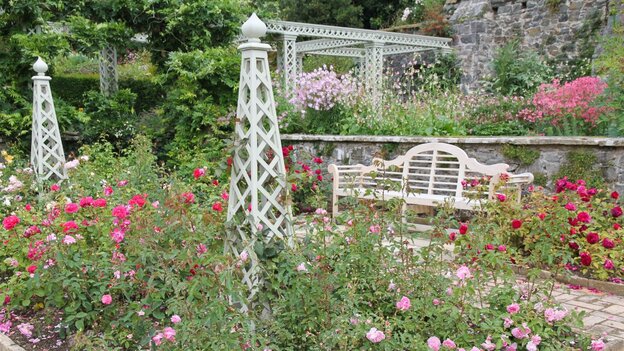
No English garden is complete without roses. They are the stars of the show, providing color, fragrance, and elegance. Climbing roses can adorn walls and arbors, while shrub roses can create stunning borders.
Consider the variety of roses carefully. Heritage and English roses are popular choices because of their scents and classic forms. Plant them among perennials to add height and interest. Or plant them in groups to create a visual impact.
Important – Pruning is crucial for health and bloom production, so ensure your clients are familiar with the needs of the specific varieties you choose.
How Landscape Design Software Can Help Design A Stunning English Garden
When designing the perfect English garden, Contemporary Style Design 3D design software is an essential tool. With it, you can:
- Visualize garden layouts with 3D models
- Experiment with plant placements and hardscape elements
- Present clients with a realistic vision of their future English garden
Contemporary Style Design’s intuitive design software breathes life into your garden plans, making it an indispensable part of your professional toolkit. Sign up for a FREE trial today and discover how Contemporary Style Design can take your landscape designs to the next level!




